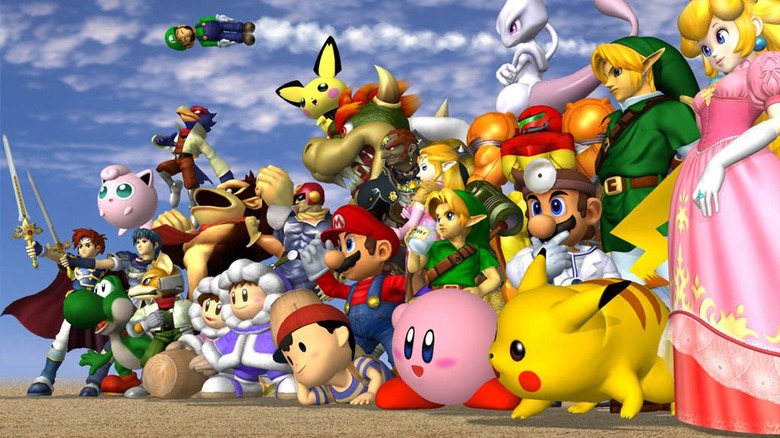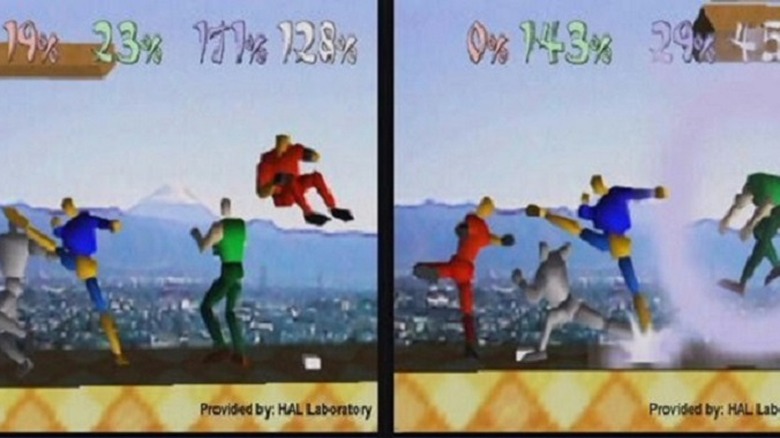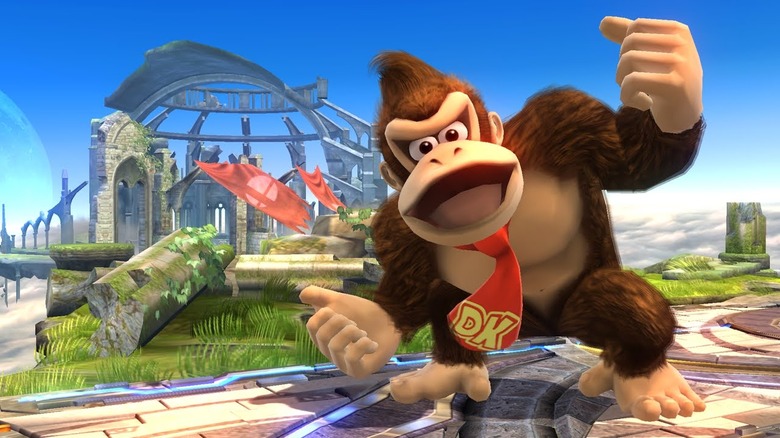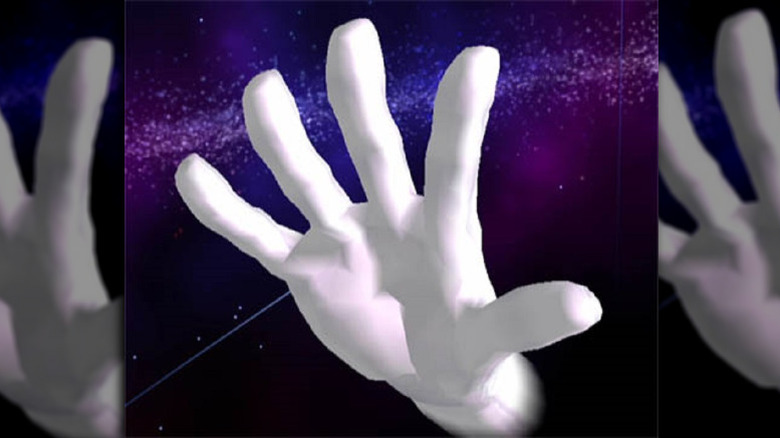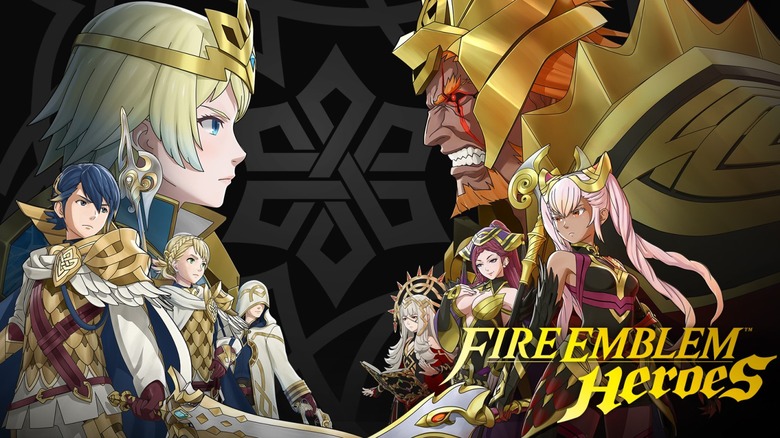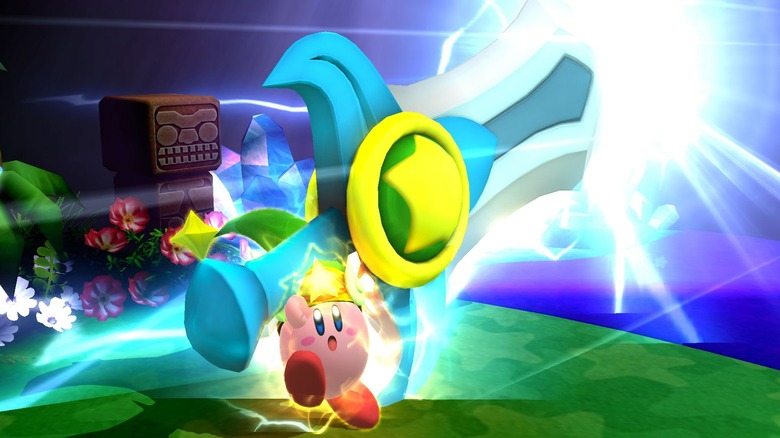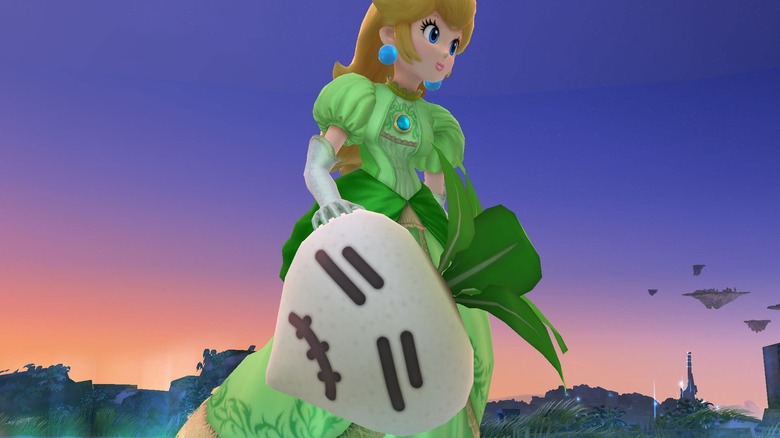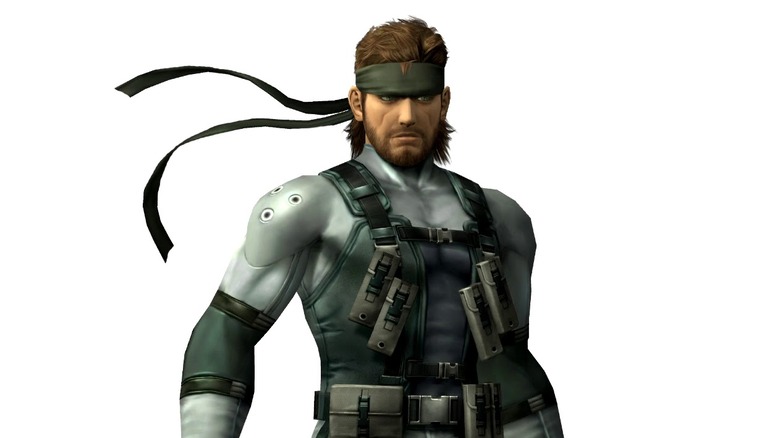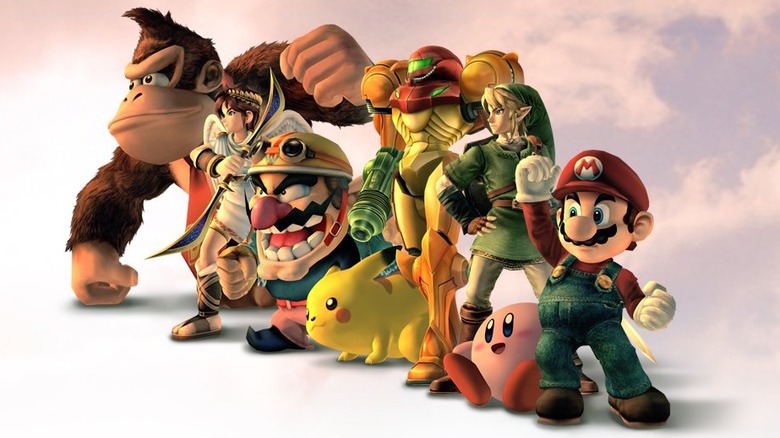The Untold Truth Of Super Smash Bros.
On paper, the original pitch for 1999's Super Smash Bros. is absolutely not something that should work. A four-player, free-for-all fighting game featuring several kid-friendly Nintendo characters beating the tar out of each other? It sounds purely like a novelty, only existing to finally settle sleepover debates of "Who would win in a fight, Mario or Link?"
Two decades later, and Super Smash Bros. is a massive property, both among casual fans and a hardcore esports community. At 2018's Evolution fighting game tournament, 2001's Super Smash Bros. Melee drew around 200,000 simultaneous viewers on Twitch, and it was the only series that had two games represented on the main stage (Melee and Super Smash Bros. for Wii U). Not bad for a game that Gamespot called "reasonably easy to master" in their 1999 review.
Today, we'll dig a bit deeper into Nintendo's brawler series and look under the hood at some of those lesser known aspects that have helped turn the series into one of the "must own" titles for Nintendo fans.
Smash Bros. almost looked very, very different
By now, plenty of games have replicated the mechanics and design choices of Super Smash Bros. When the game released, however, it was a totally different fighting game than anything else available. But it seems doubtful that it would have gone on to spawn a wildly popular franchise and garner so many imitators if it had stayed as Dragon King, the prototype that morphed into the original Nintendo 64 game.
In an interview, Masahiro Sakurai and Satoru Iwata state they began working on Dragon King as a way to get the most out of the Nintendo 64's unique controller. The two were working on it outside of their regular projects, so it was coming along slowly and not picking up a ton of traction.
However, that all changed when the two received permission to replace their generic characters in the game with popular Nintendo characters. There was no way to know just how successful Super Smash Bros. would become, but any game with the names of Link, Mario, Pikachu, and other massive Nintendo properties is sure to gain some traction. Many of the remnants of Dragon King survived the transition, however: elimination by knocking characters off the stage and the upward ticking percentages instead of the traditional health meter being the most obvious.
There are big differences in the original Japanese and North American versions
It is still fairly common, and it certainly was back in the '90s, for there to be differences between Japanese and US releases. Due to different cultures and ideas about censorship, games can look, sound, and even play dramatically different across regional releases. However, having dramatic differences in gameplay for a competitive game, especially a fighting game, is practically unheard of.
Fighting games rely on precise timing and understanding of every characters' capabilities to find success. If you load up a Japanese copy of Super Smash Bros. 64, you might be thrown off your game by just how different everything is.
There are cosmetic things, like lots of the sounds being a bit different between the two versions. However, the big difference lies in how many of the characters play differently between versions. Frame data has changed, making some attacks safer or more risky. Some characters fall faster, jump higher, or are an entirely different size. From a casual perspective, these changes won't do much to the game. But for a competitive crew, some of these changes could cause some serious shakeup in existing match-ups.
Later versions of Smash Bros. have been much more standardized, but these small tweaks are an interesting aspect of the translation from Japan to North America.
You can play as Master Hand in Super Smash Bros. Melee
The rumors surrounding games at the arcade were always the best: beating a level under a certain time would unlock all manner of secrets, or something to that effect. The juiciest were always the secrets surrounding hidden characters in fighting games: taking some unsuspecting fool to task as M. Bison proved your true mastery over Street Fighter. Still, rumors that you could take the helm as Master Hand in Super Smash Bros. Melee sounded far too absurd to be true.
But you totally can, and it's actually a lot easier than you would think. It requires precise timing, but not any convoluted "win 50 matches in a row without being hit" nonsense.
GameTrailers seems to be the first video proof that this strange glitch exists, but Kotaku writes that the unofficial Smash Bros. wiki had talked about the glitch before the video popped up.
Essentially, the glitch tricks the game into starting a match with no character, which then defaults to the first available character on the disc's memory: Master Hand. Be warned: like many glitches, this will probably cause your game to crash, and Master Hand cannot be eliminated due to having no knockback characteristics. An interesting but impractical twist on Melee.
You can thank Smash Bros. for Fire Emblem finally heading stateside
The Smash Bros. series is a veritable who's who of Nintendo characters: throwing down with Donkey Kong, Mario, and Zelda means you better have some name recognition. Even a bit more obscure characters like Captain Falcon come from big time, first-party games, and only a few truly "unknown" characters have made it in.
You can imagine a lot of Western gamers' surprise in Super Smash Bros. Melee when they unlocked a brand new hidden character by the name of Marth. And another one named Roy not long after.
These two flashy swordsmen came to us from Fire Emblem, a series that is widely popular in Japan but had not been released globally at the time Melee was released. Series creator Masahiro Sakurai stated that they were almost cut from the US release of the game, but Nintendo figured he may as well be included, since he had already been made.
The two proved to be pretty darn popular, and are partially responsible for the Fire Emblem series actually receiving a release outside of Japan. Those two obscure characters helped gain a ton of new fans for an already beloved series.
Final Smash attacks were planned in the original game
Final Smash attacks were introduced in Super Smash Bros. Brawl, and these powerful and unique moves quickly started gaining fans due to their power and over-the-top presentation. Because of the massive nature of each move, you would think that they were only introduced when a gaming system came along that was powerful enough to handle the crazy effects happening on screen. However, these moves had actually been planned in the original N64 game, only being cut due to deadlines.
In fact, Final Smash attacks were so close to making the original game that several sounds were recorded for them. You can still find some of these sounds in the original game's debug menu, including unused sound files for characters like Ness, Pikachu, and Captain Falcon. Some of these sound files were even used as they were originally recorded when Final Smash attacks did finally see the light of day in Super Smash Bros. Brawl.
Melee has a bizarre glitch that causes infinite damage
Super Smash Bros. Melee has a lot of variables to account for. The fact that there are four characters on screen, each with unique movesets, as well as item properties and stage properties to account for, means there are plenty of places for the game's data to get lost and cause problems. One of the most fascinating glitches that has popped up is the "Black Hole" glitch, which can max out a character's damage percentage in an instant.
There are a few different methods to make this glitch occur, but they both utilize another glitch that allows you to shoot the Super Scope item many more times than it should be able to. You then drop several turnips with Peach into a small area, where they will get stuck together. Eventually, there will be so many turnips in one place that any character walking into it will be trapped, taking damage all the way up to the maximum percentage.
The glitch isn't terribly hard to pull off, but it takes a bit of time and will need everyone to be working together, so it isn't something you can abuse in a match. Check out how to achieve it a few different ways right here.
Hideo Kojima's actual child got his brainchild into Smash
When Super Smash Bros. 64 released, the premise was intoxicating but still constrained: it was a massive crossover fighting game, but it could only include Nintendo characters. Mario, Yoshi, Donkey Kong, Link, etc. Even obscure characters added in Melee, like the Ice Climbers or Marth and Roy, still met that limitation.
Leave it Hideo Kojima to turn that rule on its head. More specifically, Hideo Kojima's son.
You see, Kojima's son is a huge fan of Smash Bros., and father and son frequently battled it out in game. Endgadget reports that Kojima claimed his son was playing Smash Bros. one day and commented that there were no characters his father had created to choose from. Kojima contacted Sakurai and Iwata to ask them if Solid Snake, star of the Metal Gear Solid series, could find a slot in the next version of the game.
Soon enough, Snake made his debut in Super Smash Bros. Brawl. He was the first third-party character to make an appearance in the series, but certainly not the last. Since then, characters like Cloud Strife (Final Fantasy VII), Bayonetta, and even Mario's longtime rival Sonic the Hedgehog have appeared as playable characters.
The Smash Bros. Brawl announcer is the announcer from Bill Nye the Science Guy
Super Smash Bros. Brawl just feels epic, and a huge part of that is the booming voice of the game's announcer, Pat Cashman. The name might not stand out to you, but you've heard his voice. Cashman got his start working on television and radio in Seattle, Washington. His most successful credit is most likely as a writer and performer on the Emmy-winning sketch comedy show Almost Live! He also wrote and performed in several commercials for the Seattle Mariners baseball team.
But you probably know his voice as the announcer of everyone's favorite high school "Movie Day" selection: Bill Nye the Science Guy.
That's right: Brawl and Bill Nye share the same announcer. It's very fitting that two of our favorite things from childhood have the same voice speaking for them. It also makes sense why the executives at Nintendo would be familiar with Cashman: operating out of Seattle would mean his dulcet tones are frequently heard at Nintendo of America's Redmond, WA headquarters.

